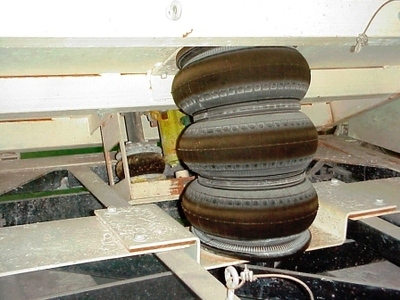Air springs overcome demands of fine minerals and powders handling
Friday, 26 October, 2012
Powder-handling tasks typically impose rigorous demands upon the actuators and isolators used in their materials handling systems.
Not only must they be able to cope with dust, abrasion and fine particles that can damage the rods and seals of conventional cylinders - risking production stoppages - but also they must be able to cycle rapidly in actuation roles and to control high levels of noise, vibration and harshness (NVH) in isolation roles.
“Because fewer moving parts and reduced complexity usually equate to less wear and more reliability, we are encouraging powder processors to consider air spring actuators and isolators in new applications. Firestone air springs - called Airstrokes and Airmounts - are particularly appropriate in situations requiring rapid cycling, high reliability and minimal susceptibility to wear in grimy industrial situations,” says James Maslin, National Sales and Marketing Manager for Air Springs Supply Pty Ltd.
Air Springs Supply and Firestone engineers internationally are developing expanding uses for the flexible-wall, bellows-type Airstroke and Airmount air cylinders. These air springs are, in essence, tough, fabric reinforced rubber balloons of different shapes to perform different tasks. Operating without rods or seals, they can be small enough to fit in the palm of a hand, or more than a metre across and capable of producing 40,000 kg of force.

One powder-handling project in which they were employed involved Semi-Bulk Systems Inc, a US company that manufactures state-of-the-art equipment and containers for unloading, batching and processing bulk quantities of fine dry powders, including products of industries such as food and beverage, dairy and industrial and chemical products, including paint and paper components.
Semi-Bulk Systems’ process for unloading vinyl bags of powder of 400-3800 kg had previously been simply to discharge the product through a hole in the bottom of the bag. The problem with that was that the product came out in big slugs, rather than evenly and smoothly.
Semi-Bulk’s solution to this issue was to blow air through the powder to break it up and make it fluffy, so it could discharge through a 100 mm hole at the bottom of the container. The container allowed for controlled flow of material through its use of a support stand with a hinged deck, beneath which an Airmount isolator was inflated at about 1 bar. The stand supported the container at its corners with hooks, allowing gravity to dispense the powder through the hole in the container floor.
“Semi-Bulk’s system put the container on the deck and let it begin to empty through gravity. When the powder got down to about 25% left in the container, the pressure in the Airmount was greater than the weight of the container, causing the hinged deck to rise. This tilted the container so the remaining powder flowed evenly toward the discharge port,” says Maslin.

Semi-Bulk used double-convoluted Airmounts for smaller bags and the triple-convoluted Model 38s for larger bags. These Airmounts (which already have been in use in Australia for years in heavy industrial plant) have a maximum diameter of approximately 950 mm and load capacity of 40,000 kg at 5.5 bar and maximum stroke of 350 mm. Semi-Bulk’s process also included a smaller Model 16 Airmount that inflated when the hinged deck tilts, activating an air piston vibrator that vibrated against the container base and helped dispense the powder further.
The Airmounts replaced air cylinders used previously. Key advantages of the change were that Semi-Bulk Systems could use one Airmount to replace two conventional cylinders. Also, conventional air cylinders always required some lubrication or maintenance, which the Airmounts did not. And the Airmounts were hidden under the deck, so there was nothing exposed to clean.
Maslin says a major advantage of the Airstrokes and Airmounts is that they don’t use the guides and seals found in traditional pneumatic cylinders. This difference is the key to many of their benefits in rigorous production environments, ranging from metal stamping, vibrating screen and conveyor applications through to labelling, sealing and packaging tasks. Airmounts are used in Australia to isolate equipment as diverse as compressors, computers, generators and refrigeration and air-conditioning equipment.
Milk powder: a global formula for food security
Manufacturing milk powder is an energy-intensive and costly process. As demand for...
Safer, smarter and faster: automation delivers at Coca-Cola’s Brisbane warehouse
Coca-Cola's warehouse in Brisbane needed a flexible warehouse and palletising system that...
Robotic storage system transforms NZ pharmaceuticals warehouse
New Zealand's first AutoStore has significantly improved intralogistics operations for...











